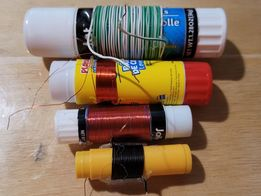SolderSmoke #240
Monday September 19, 2022
http://soldersmoke.com/soldersmoke240.mp3
Sorry, I had some technical difficulties so my audio is a bit distorted.
NIMCELS? Niche Internet Micro Celebrities. I dunno.... Can our listeners come up with an acronym
that describes our place in the universe?
Sponsors: Parts Candy. Carlos in Chicago. Great
leads. Don't scrimp with a crimp! You need some good quality test leads on your workbench. Get yours from Carlos. Click on the picture on the blog page or go to PartsCandy on e-bay.
"Techno Wizardry"? Our lawyers at
Dewey Cheatham and Howe will be after them for that!
Bill's Bench:
Hex Beam has made me a DXer.
91 countries. Having fun. Mozambique (Long path), San Andres island, and Saudi Arabia, all on Friday. All homebrew SSB 100 watts.
Put my old 20 meter CW station back on the air: Barebones superhet and the VXO 6 watter. WYKSYCDS. This may be one of very few CBLA Receivers in the world!
Been getting active in the Vienna Wireless Society. Dean KK4DAS is President and a lot is
happening in the Club. Makers group. Lunch
with the group on Tuesdays. Lots of fun.
We are looking at Farhan’s Daylight Again Analog rig. Using parts from Dean’s 3D printer, we have
made PTOs. See blog post for picture. (But are they really PTOs? Or just Variable
Inductors?)
VFO madness. Solid stating an
HT-37 VFO. Grayson: “You have clearly lost your mind.” Perhaps. 100 MHz FM broadcast RFI. This brought me to
capacitors and linear tuning:
SLC, SLW, SLF and Midline/Centerline caps. Do special caps explain why some VFOs have
linear tuning while others do not? NO,
not really. You can get linear tuning
with ordinary caps. See blog post
Working on the bench. Reading
Adam Savage’s book on workshops and tools. (link to the book in the right hand
column of the blog. Some other
workbench links on the blog. Upgrading
tools and test gear. I have a proper bench
power supply. Better side cutters.
Engineering rulers. Digital calipers.
Better solder (I was talking to Ron WA6YOU – a real solder authority - about
this. Kester 60/40 ).
SHAMELESS COMMERCE DIVISION:
mostlydiyrf.com
Currently offering seven
items:
· UDVBM-1
(in three versions)
·
PG-TIA Broadband IF Amplifier
·
TIA-AGC IF Amplifier
·
Dual-Gate MOSFETs
·
OA741D Op-Amp (discrete components)
·
8-Pole QER Crystal Filter
·
I2C Rotary Encoder
Three more are shown as coming
soon:
·
GP Audio Amp (general-purpose audio amp)
·
HyCas IF Amplifier with AGC
·
M-Cubed (Michigan Mighty Mite kit)
·
Mostly DIY RF offers hardware for
hardware-defined radio. That's not a comment on software-defined
radio. SDR is cool and useful, and it has its place.
·
In fact, I believe in explicitly
making use of technology from all eras (vacuum tubes,
discrete semiconductors, and integrated circuits
·
What does "mostly" DIY mean? It
means making what you want and using ready-made for the rest. Even the most
fanatic DIY'ing home brewer does this without much thought. He uses components
he didn't fabricate, electricity he didn't generate, and theoretical knowledge
he didn't discover. One can't fight all battles, one has to
choose which to fight and which to leave to others. If an appliance-operating
Ham doesn't want to fight at all, that's okay, but Mostly DIY RF has
nothing to offer him.
--------------
I need YouTube viewing hours. So I am
putting some of the best SolderSmoke podcasts up on the YouTube channel. Please listen/watch on YouTube. Here is the
playlist: https://www.youtube.com/playlist?list=PLv9MEKq1quk-gnxog7eBqY_y7cpQadf6T
Google feed no longer sending our e-mails.
So please follow the blog, Get yourself a blog feed reader. I use Feedly.
It is free. Download, search in
Feedly for SolderSmoke, hit subscribe and you are done. https://feedly.com/i/discover Follow
Pete’s blog too! It is easy.
Pete’s Bench
Resurrections:
SBE-33!
TenTEC Model 540
KWM-1
Mailbag:
Dan KC5VPI getting into homebrewing. No longer WRONG!
Michael AG5VG built subharmonic DC receiver, put it on 40 and 20. FB.
Mike AA9IL working on old tube stuff including a DX-100 AMD UUHF gear up to
122GHz.
Ed WA4MZS liked the SolderSmoke book. USCG vet. As is Mike Rainey AA1TJ Semper Paratus!
Clint KA7OEI – The Music of the Beams – My Hex does not sing! So far!
Walter KA4KXX – The Knack started early.
Video of getting a toolbox for Christmas. And working on PTOs! He likes them!
Phillip G4HOJ Also working with subharmonic mixers – using the more complex
4 diode version.
Peter GW4ZUA Built an amazing rig from RADCOM (1980s) Cool VFO with varactor
fine tuning and a coil with a dust core that was cut in half to minimize temp
effect. Box now holds 3 band version of
Pete’s SimpleCeiver. FB.
Bruce KC1FSZ building 25 Watt amp for his Peppermint Bark rigs. We won’t turn him in to the QRP authorities.
Grayson KJ7UM tested the 12BY7A from my DX-100 VFO. It was in fact weak. Thanks Grayson.
Charles Smith KV4JT has some really interesting stuff on how
to solid state tube gear. Especially
R-390s. https://soldersmoke.blogspot.com/2022/08/trigger-warning-solid-stating-old-tube.html
Gianfranco I0ZY Old friend from Rome. Amplifier manufacturer. FB.
Paul WA1MAC getting started again after long hiatus.
Vasily.. I mean Todd VE7BPO.
Always great tech info. Thanks.
Mark WB8YMV building a superhet with a 455 kc IF.
I sent Farhan some comments on his Daylight Again video: He
wrote back “I marvel at their stamina to watch an hour long video of a
man talking with a funny accent!”















.png)









